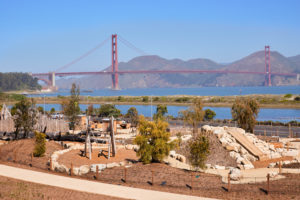One perennial reason for living in the Bay Area is that there’s no off season for getting out into the parks.
In February I went to Huckleberry Botanic Regional Preserve to explore its self-guided nature trail, where interpretive signs describe the preserve’s unique geology and plant life. Standing in front of the preserve’s trail map, I chat with a trio of strangers who are curious about the plants, like I am. When I start down the trail, some 200 yards in I pass an elderly couple who say they have hiked the loop; I tell them they’re almost to the entrance. A young guy with headphones passes me, then a couple of runners. I cross paths with a pair of young women chatting happily. I see a hipster couple relaxing on a bench eating, snuggling, and taking in the view of distant Mount Diablo.
As I begin to hike up out of the preserve’s canyon, an older woman with hiking poles and I exchange words about the sprinkles of rain starting to fall. She says that while she was sitting in her car tiny beads of hail were bouncing off the windshield. I start walking up the hill a little faster but within minutes the winter rain we’d all been waiting for starts to pelt down in icy, white pebbles. The sound is tremendous, like a great rattle, as the hail hits the thick canopy overhead. I start to run and by the time I make it back to the trailhead the creases in the fabric of my backpack and jacket are packed reservoirs of melting hail. There’s nothing like getting caught outdoors in a good storm to make you feel alive.
Our parks are where we collect hailstone war stories, where we learn, exercise, socialize, observe, flirt, find solace. Where we ensure animals and plants have space to thrive, and we chat with strangers to encourage and inform each other. So much of the good stuff in life happens in these natural places, and it all depends on our parks functioning in ways we can too easily take for granted.
As many readers know, California’s state park system faced a crippling budget crisis in 2011 and as a result 70 of the state’s 280 parks were nearly closed. Since then, it’s been seven challenging years of shoring up and attempting to remake the state system, a subject reporter Alissa Greenberg explores in “The New California State Parks”, consulting more than 100 sources and people. Not surprisingly, Greenberg found that the climb back from a decades-in-the-making crisis has been messy and complicated, and there’s a long way to go yet.
It’s worth taking stock of the progress now, though, because this June a state bond measure that authorizes $4 billion for parks and water projects will be on the ballot. Since 2011 the parks department has received an average of $121 million annually from the state’s general fund (a fraction of what it costs to manage California’s 1.6 million acres of state parks) making a park bond’s necessity almost preordained. Wrapped up in its passage is whether our park land can continue to provide all of us—in principal the young and old, able bodied and mobility challenged, black and white—with the good stuff that enriches our lives and world.




